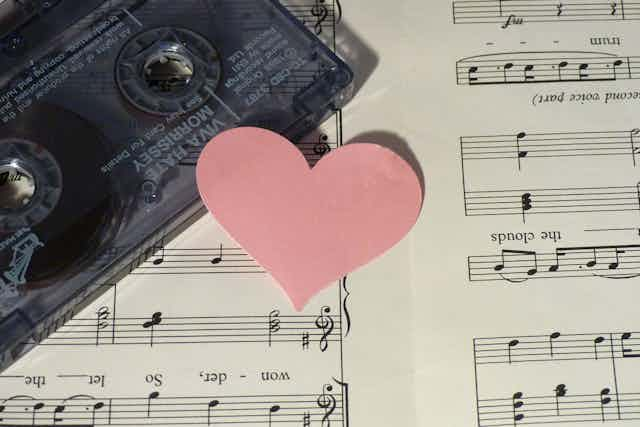My wife Theresa represents many things for me – in addition to being my partner, I see her as a 17cm-long quarter-wavelength resonator (which I hope you’ll understand and agree with by the end of this article). Romance, as you’ll have noted by this stage, is most definitely not dead. Theresa is also a noted operatic soprano. In the one person she combines the artistry, feeling and lyrical tones of her craft with some beautiful physics.
For me, physics has an aesthetic beauty of its own, expressed through a small number of universal principles that sweep across a range of apparently unconnected applications. From Theresa, let’s take the principle of resonance which is where we can make large vibrations if we push something at a rate that is the same as its natural frequency.
Imagine you want to push a child’s swing. The swing has a natural frequency or rate of vibration at which it swings. If you push the swing at a rate much faster than its natural frequency not much happens; the same goes if you push at a very slow rate. But, if you push it at a rate that is the same as its natural frequency, then with very little effort you produce very large oscillations. We have resonance.
The general physics principle is that you have resonance whenever an external source vibrates a system at its natural frequency.
You can certainly break a wine-glass using sound, as the video below aptly demonstrates. What matters is not so much the volume of the sound but the precise matching of the sound to the natural frequency of the wine-glass to give resonance. A glass of wine has a natural frequency of 791 Hz.
If the sound from a loudspeaker is 790 Hz or 792 Hz then nothing happens, but 791 Hz produces violent vibrations.
Other areas where we find resonance include: radio tuners, MRI (Magnetic Resonance Imaging), bridge dynamics, road corrugations, and virtually all musical instruments.
This is what I mean by the economical beauty of physics: the same principle is enacted again and again.
The natural frequency of an instrument such as a guitar depends on what are called “standing waves”. The video below illustrates the basics.
Imagine you are standing on a seawall watching the waves roll in, hitting the wall and reflecting back out to sea again. If a reflected wave meets the next incoming wave then the two waves run in to each other, producing a spectacular pile-up of water - we have a standing wave.
The idea of a standing wave is another unifying principle in physics found not only with water waves but also in meteorology, lasers, antennas, quantum mechanics and musical instruments, whether they be strings, woodwinds, brass or percussion.
The standing wave for a vibrating guitar string has no vibration at its ends and maximum vibration at its middle, and so is half a wavelength long.
One complete wavelength goes from a point of no vibration (a node to a maximum vibration in one direction, through a second node to a maximum vibration in the opposite direction and back to a node; after that the pattern repeats. The frequency of the string depends on the wavelength.
A short string has a short wavelength and a high frequency. A long string has a long wavelength and a low frequency. The same idea applies to columns of air, such as organ pipes.
A very long pipe has a long wavelength set by the length of the pipe and a very low frequency, while the opposite happens for very short pipes. The pipes resonate at a frequency set by their length.

The picture above shows what’s known as a Rubens tube – a physics apparatus for demonstrating standing waves. I used the one you can see in a recent public lecture because it gives a beautiful demonstration of standing waves.
I made my tube from drainpipe with one end blocked off and a loudspeaker mounted in the other end. I drilled small holes in the top and coupled the tube to a gas bottle. The speaker launched sound waves down the tube that reflected from the far end making a standing wave pattern with alternating regions of high and low pressure as is clearly shown by the height of the flames.
Changing the frequency produced different resonances in the tube. Playing Scotland the Brave on the bagpipes through the speaker produces remarkable dancing flames.
Now let’s come back to my wife, Theresa (see the video above). If you have a pipe that is open at one end and closed at the other you have a maximum at the open end and a node at the closed end. This corresponds to a quarter of a wavelength.
When Theresa sings she opens her throat by raising her soft palate and lowering her larynx. She calls it the “yawning” position because a full yawn naturally opens your throat. The effect is to produce a lovely open column of air nearly closed at her vocal folds (a node) and open at her mouth.
She has produced a quarter-wavelength long resonant pipe. Using a tape measure I find that the distance from her open mouth to her vocal folds is about 17cm. I wasn’t just sweet-talking her before: she really is a 17cm-long quarter-wavelength resonator!
It is the power in this resonance - the singer’s “formant” - that allows her to soar above a full orchestra.
As I sit in an audience captured by the beauty of her voice I still marvel at the physics behind it all.
Further reading: Music and physics – the connections aren’t trivial

